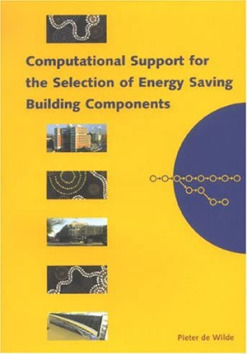Energy Saving Components
In full, the title of this work is Computational Support for the Selection of Energy Building Components. The underlying research was carried out under supervision of Rien van der Voorden and Jan Brouwer at the TU Delft, as well as Fried Augenbroe at GeorgiaTech. The thesis was published by Delft University Press (DUP, now part of IOS Press) and defended on March 8th, 2004.
The following is the abstract from the thesis:
Buildings use energy for heating, cooling and lighting, contributing to the problems of exhaustion of fossil fuel supplies and environmental pollution. In order to make buildings more energy-efficient an extensive set of ‘energy saving building components’ has been developed that contributes to minimizing the energy need of buildings, that helps buildings to access renewable energy sources, and that helps buildings to utilize fossil fuels as efficiently as possible. Examples of such energy saving building components are heat pumps, sunspaces, advanced glazing systems, thermal insulation layers, etc.
Building simulation tools appear to be a suitable instrument to support decisions regarding the selection and integration of energy saving building components: they can provide detailed information on the thermal performance of buildings that have not yet been built, thereby allowing objective comparison of different design options under identical conditions. However, in general the actual use of simulation tools to provide information to support the selection of energy saving building components does not live up to this expectation. The development of new building energy simulation tools shows a continuous increase of capabilities and complexity. This trend increases the dependency on adequate modeling and expertise, and thereby increases the barriers to integration of building design process and building simulation even further.
Therefore, the central goal of the PhD-project is the development of a strategy to provide computational support during the building design process for rational design decisions regarding the selection of energy saving building components. The strategy is to be substantiated by development of a prototype that demonstrates the feasibility of the strategy.
The work presented in this thesis consists of four main research activities, all focusing on the use of simulation tools to support the selection and implementation of energy saving building components: 1) analysis of the design process of current energy-efficient building projects; 2) development of an approach for well-founded selection of these components; 3) analysis of the suitability of existing tools to support the selection process, and development of ideas for improvement of these tools; 4) development of a strategy as well as a proof-of-concept prototype that provides support for the selection of energy saving components and that demonstrates the viability of the proposed changes.
Analysis of current energy-efficient building projects
The analysis of current energy-efficient building projects was initiated by a lack on unbiased information on the way in which energy saving building components are selected in current practice, and lack on information of the role of simulation tools in this selection process. The goal of the analysis was to find out for recent prestigious building design projects in the Netherlands how this selection took place, and what role tools played in supporting the selection.
In order to attain this goal three case-studies and a survey were conducted. The case-studies provided in-depth information on three projects; the survey demonstrated the representative ness of the findings from the case-studies for a larger sample of energy-efficient buildings.
The overall findings are that in current projects simulation tools do not play an important role in the selection of energy saving building components, since these tools are used in later phases than those relevant for the selection, and are only used for different purposes (optimization and verification rather than to support choices). Instead, most energy saving building components are selected based on analogy: use of similar components in previous buildings by the architect or consultant, or the use of these components in demonstration projects. It appears that decision-making on energy saving building components is based on simple, heuristic decision rules. Yet it seems preferable to apply multi-criteria decision rules to the selection of these components, ensuring that different requirements are considered in the decision-making process. Hence there is a need to improve both the selection procedure as well as the tools that support that selection.
An approach for well-founded selection of energy saving building components
The development of an approach for well-founded selection of energy saving building components had as goal to improve the current way of selecting these components. Requirements and constraints for making well-founded choices have been identified and used to assess existing theories for making design decisions. An approach for performance-based selection of energy saving building components has then been developed, using applicable elements from existing theories to define the essential steps: definition of an option space, identification of relevant functions, specification of performance indicators, prediction of performance for all options and all performance indicators, and evaluation followed by selection of the most desirable option.
This approach rationalizes the selection procedure, and makes the role of subjective assessment explicit. Since it is based on performance prediction, it provides an optimal base for the use of simulation tools. The viability of this approach has been demonstrated through application of the approach to an example.
Analysis and improvement of tools
Once the selection procedure had been developed, the next goal was to improve the tools that support this procedure. The analysis and improvement of tools for the selection of energy saving building components consisted of the following steps: analysis of the different main categories of tools (design tools, modeling tools, analysis tools, support environments and others) and their role in supporting the selection of energy saving building components, and assessment of existing tools as well as identification of possibilities for improvement of the two most important categories (analysis tools and support environments).
It was found that existing analysis tools are capable of supporting the selection according to the performance-based approach, on condition that enough time and expertise is available for the modeling and simulation work. Support environments are mostly still under development and have not yet gained widespread use.
Analysis tools can be improved through reverse-engineering, which clarifies the building design alternatives and performance indicators that can be handled by these tools. Support environments can be improved by embedding analysis tools as well as a selection mechanism that helps users to find a suitable (analysis) tool for any specific (analysis) job.
A strategy and prototype for the selection of energy saving components
The final goal of the research project was the development of the strategy to provide computational support during the building design process for rational design decisions regarding the selection of energy saving building components, and the realization of a substantiating prototype that shows the viability of this strategy. In order to reach this goal the afore-mentioned ideas on improvement of the process and support tools have been combined. Participation in an international research project, the Design Analysis Interface (DAI) - Initiative, provided the final elements needed for completion of the research.
A strategy for selection of energy saving building components has been developed in this thesis that consists of the following elements:
- Energy saving building components should be selected according to a procedure that consists of definition of an option space, identification of relevant functions, specification of performance indicators, prediction of performance for all options and all performance indicators, evaluation of predicted performance and selection of the most desirable option.
- Availability of time and expertise for modeling and simulation work are the most important limiting factors that hinder the application of existing building performance simulation tools in support of the selection of energy saving building components. In order to overcome this problem the analysis request must be stated unambiguously. At the same time, building performance simulation tools must be pre-conditioned (reverse-engineered) in order to meet these specific analysis requests.
- The procedure for the selection of energy saving building components must be assisted by the use of a support environment that provides a mechanism that gives users access to different (embedded) building performance simulation tools for doing specific analysis tasks.
A prototype of a Design Analysis Interface (DAI) - Workbench has been developed that demonstrates the feasibility of better integration of building analysis tools and building design process through the use of a layered, process-centric approach, thereby showing the viability of the ideas to provide improved computational support for the selection of energy saving building components. The concept of analysis functions links the analysis process with simulation tools by matching analysis task and tool capabilities. An analysis function gives an exact specification of the performance indicator that is to be generated by the analysis.
Of course, full computational support for the selection of energy saving building components can only be achieved once the DAI-Workbench contains a set of analysis functions that covers most relevant performance aspects for buildings with such components, plus qualifying tools and interfaces from analysis functions to those tools.
Future work on the integration of building simulation and building design requires further development of support environments that capture and support the analysis process itself, and that provide access to tools that are able to support relevant process steps. Reverse-engineering of simulation tools to match specific analysis tasks seems an important task in order to increase the applicability of these tools.



